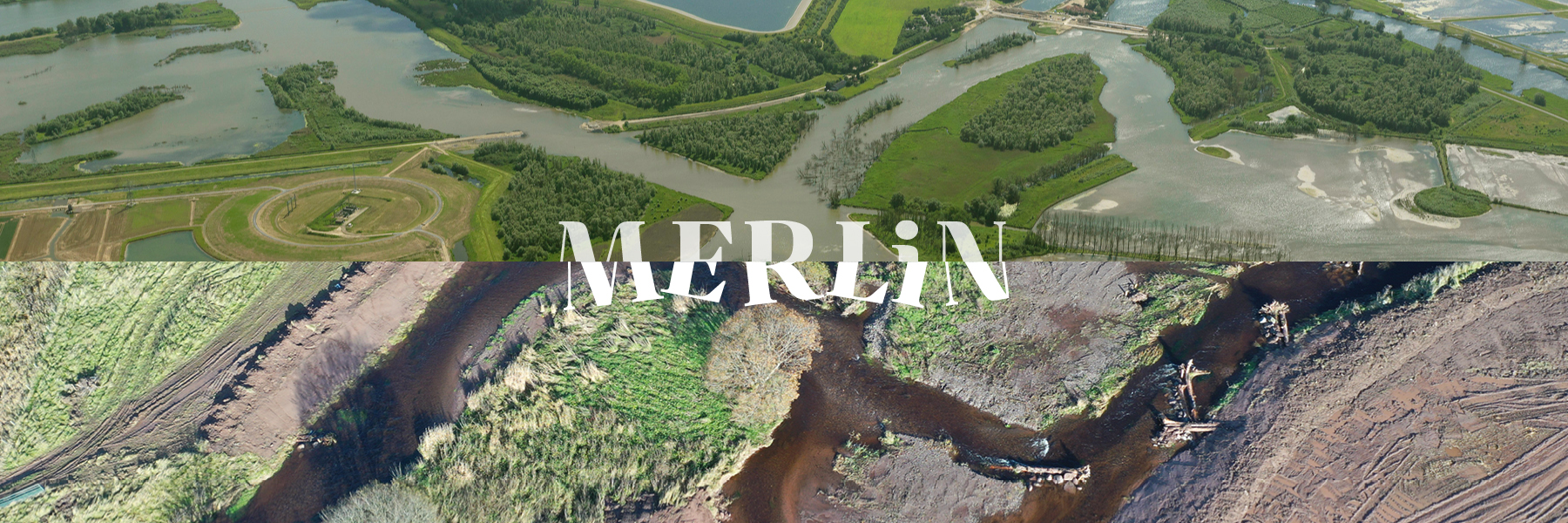MERLIN Deliverables
D1.1 D1.2 D1.3 D1.6 D1.7 D2.1 D2.2 D2.3 D2.4 D3.1D3.3 D3.5 D4.1 D4.2 D4.3 D4.4 D4.5 D4.6 D4.9 D5.1 D5.2
Deliverable D1.1
Online case-study portal to share knowledge and report findings (09/2022)
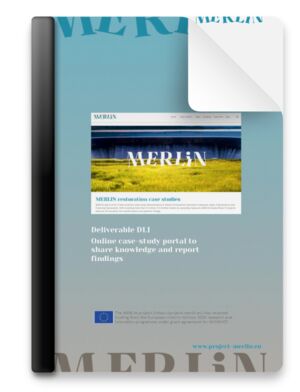
Key messages:
- The MERLIN online case-study portal is designed to share knowledge of the 17 MERLIN case studies.
- The portal provides interactive access to information from case-study level to European scale and across the restoration types including Peatland & Wetland, Small Streams and Basins, and Large Transboundary Rivers.
- Each case-study has a unique page through which details of the restoration activities, objectives and key stakeholders can be viewed.
- The portal has been designed to allow dissemination of data on Case-Study Impact Assessments across MERLIN Indicators for the European Green Deal.
- The portal will also indicate progress in the implementation of new restoration measures in the MERLIN case-studies through application of the IUCN Global Standard for evaluating Nature-Based Solutions.
- The portal provides an important dissemination tool to inform the scientific community as well as the general public on the benefits of restoration across scales.
Deliverable D1.2
New framework for monitoring systemic impacts of freshwater and wetland restoration actions (updated Version 11/2024)
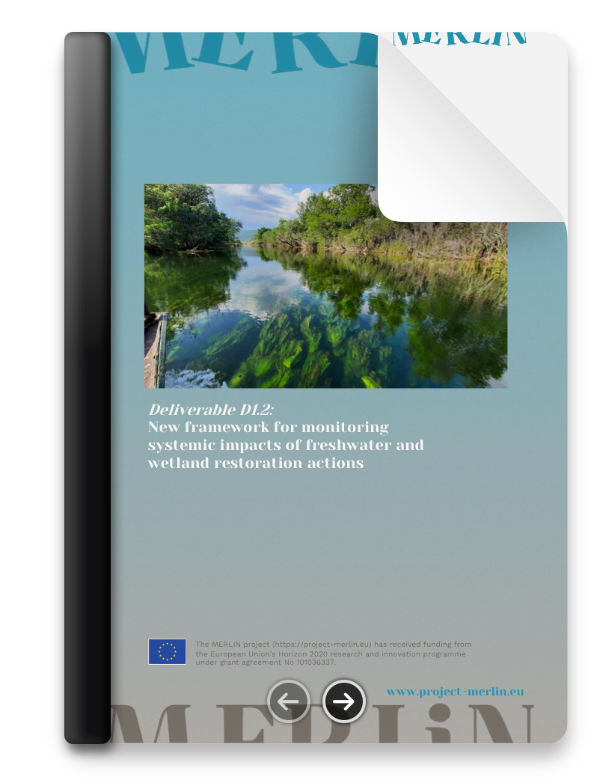
Key messages:
- Robust demonstration case-studies are needed to evaluate whether improvements in ecosystem condition are translated into improvements in ecosystem services.
- This research is essential for effectively scaling-up nature-based solutions across Europe and providing the evidence to support transformation agendas in society and industries, and ultimately supporting the ambitions of the European Green Deal.
- Clear guidance and standardised indicators help monitor the impact of freshwater and wetland restoration measures on European Green Deal goals.
- These monitoring indicators should include environmental indicators (e.g. for biodiversity, greenhouse gas emissions and water storage capacity) as well as socio-economic indicators such as stakeholder representation, private finance mobilisation and job creation.
- A combined Before-After-Control-Intervention (BACI) monitoring design is recommended to provide robust evidence and attribute change to the restoration measures.
- Benchmark (cost or effort) and local/regional context data (e.g. land use, governance) are also needed alongside monitoring of impacts to not just measure what has happened at a site but to understand why it has happened.
Deliverable D1.3
Digital Twins of four case-studies and “stories” (09/2024)

Key messages:
- The Digital Twin case studies highlight four of MERLIN's projects and their use of Digital Twin technology.
- The StoryMap is designed for both the public and practitioners to learn about Digital Twins and their potential application in freshwater ecosystem restoration.
- The story board breaksdown Digital Twins into four key components: Big Data, modelling, decision-making interfaces, and engagement.
- Each case study features a separate slide deck that showcases the restoration focus of the site along with one aspect of the Digital Twin technology.
- The portal allows users to learn about MERLIN, follow relevant links to dashboards, and interact with the site by sharing their thoughts on Digital Twins.
Deliverable D1.6
Manuscript and policy briefing evaluating success of large landscape-scale restoration (05/2025)
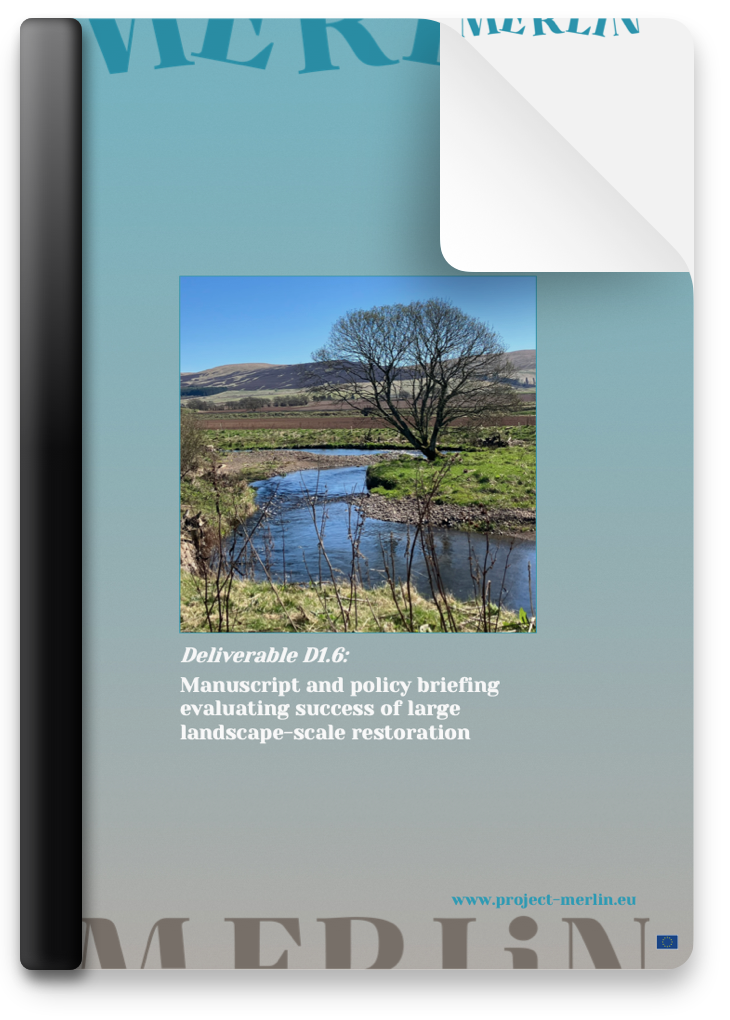
Key messages:
-
MERLIN monitoring confirms that well-designed Nature-based Solutions can deliver substantial environmental, social, and economic benefits, directly supporting European Green Deal objectives including biodiversity, climate resilience, and sustainable development.
-
Systemic, structured monitoring is essential for scaling restoration efforts. MERLIN’s approach provides decision-makers with the evidence needed to adjust interventions, allocate resources strategically, and ensure long-term effectiveness.
-
All 18 case studies completed structured reporting across Peatlands & Wetlands, Small Streams & Basins, and Large Transboundary Rivers, enabling comparative evaluation across landscape types and informing targeted governance responses.
-
Environmental outcomes were most robustly reported, particularly Biodiversity Net Gain and Climate Regulation. Gaps in socio-economic and sectoral criteria highlight the need for stronger integration of these dimensions into monitoring and planning.
-
A traffic light scoring approach combined impact direction and data confidence, providing a clear visual synthesis to support rapid decision-making and performance tracking.
-
High-confidence results were observed for Biodiversity Net Gain, backed by quantitative data such as 287 km of restored river stretches and 1,528 ha of rewetted or reconnected floodplain and wetland areas. Lower confidence for Zero Pollution and sectoral indicators signals priorities for improved data and methods.
-
Narrative insights complemented quantitative data in several cases, especially in complex settings. These enriched understanding of restoration outcomes and informed context-sensitive adaptation.
-
Trade-offs were reported, including temporary pollution increases and loss of agricultural land. Transparent identification of such tensions is critical for managing conflicts and aligning ecological restoration with socio-economic needs.
Deliverable D1.7
Revitalizing small streams - A practical guide for community action (03/2025)
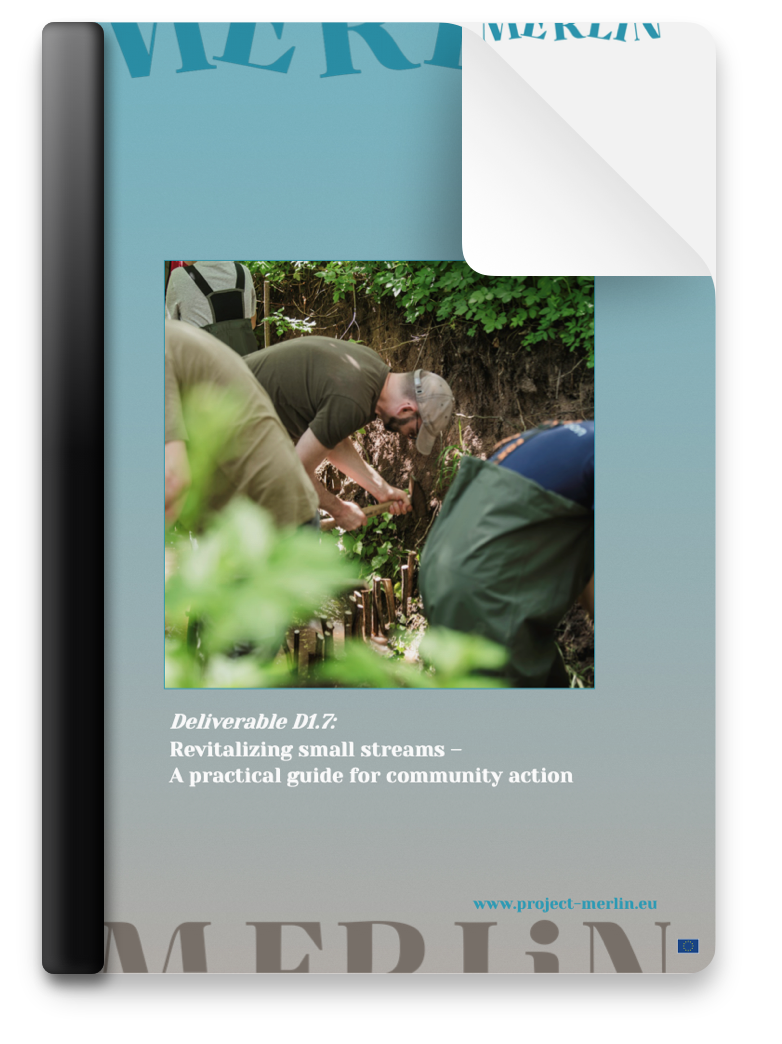
Key messages:
- Training material for the monitoring of small streams by citizen scientists according to FLOW project protocols is available in English language and was tested in Ghent (BE).
- The ecological status of small streams is assessed before and after the implementation of citizen science (CS) restoration measures based on FLOW monitoring protocols for hydromorphology and benthic invertebrates.
- A process description helps volunteers to check local conditions, to develop agreements between stakeholders and to implement site- and group specific measures.
- We provide fact sheets on three different CS stream restoration measures: Installing wood structures, gravel micro-groins and planting alders.
- We present approaches to monitor temporal changes in the benthic invertebrate community using the bioindicator EPT ratio.
Deliverable D2.1
Case study optimisation strategies (12/2022)

Key messages:
- A SWOT analysis of the IUCN criteria for nature-based solutions to support European Green Deal goals yielded a broad spectrum of information on the MERLIN freshwater restoration case studies.
- This information provides the necessary ingredients to draft an optimisation strategy for the MERLIN case studies on themes including multiple goals, society, restoration techniques, economy, policy and regulations.
- This information offers a basis for peer-to-peer learning between the case studies and those in other regions.
- The optimisation strategies provide new insights and broaden perspectives on restoration actions in individual case studies.
- Identifying the potential for multiple Green Deal goal achievements will initiate broader dialogues with stakeholders and provide new incentives for restoration with multiple benefits for local people.
- Capacity building on financia larrangement swill create new opportunities for restoration actions.
- Clear and agile policy arrangements are needed to enhance stakeholder participation in restoration actions.
- The visioning, planning and evaluation of restoration actions are long-term activities that benefit from adaptive approaches and sound long- term monitoring programs on multiple aspects of biophysical and socio-ecological systems.
Deliverable D2.2
Synthesis of the Interim Regional Scalability Plans (04/2023)

Key messages:
- The interim regional scalability plans (RSP) are the next step on the roadmap to upscale freshwater ecosystem restoration after the optimisation strategies (MERLIN Deliverable 2.1). They offer visions for upscaling restoration across wider areas by 2050.
- A template has been designed for collecting input using the manual "Scaling up - From vision to Large-Scale Change. A Management Framework for Practitioners" (Management Systems International 2016).
- Seventeen case studies have prepared their interim RSPs answering questions related to the 'what, 'why', 'where', 'how', and 'who' of scaling up restoration initiatives.
- Further dialogue between cases from each cluster will provide inspiration and feedback to work towards a final RSP at the end of the MERLIN project.
- The upscaling in the RSPs has a time horizon towards 2050, and recommendations have been made to strengthen this visioning. This long-term visioning should be linked with stepwise implementation, for which the use of adaptive pathway thinking can be used as inspiration.
- The term 'restoration' of freshwater ecosystems might put people on the wrong page in the light of changing climate and land use and the time horizon of the RSP. Improving freshwater ecosystems should take these shifting conditions into account to define realistic targets both for biodiversity and delivering ecosystem services.
- The formation of multidisciplinary teams that cover the bio-physical, socio-economic and legal/financial aspects of the RSPs is beneficial for the overarching success of the plans. A well embedded monitoring strategy across all these disciplines is needed.
- The interim RSPs have been prepared by each case study without interaction with the other case studies. The other interactions are with the financial expertise within MERLIN, the outcomes of the sector roundtables and with the case study board. These interactions will be the main actions to improve the RSPs.
- RSPs are designed within the MERLIN project.The implementation of the RSP will be a process to start once the MERLIN project has ended in 2025. During MERLIN, it is essential to define the consortium to adopt and implement the RSP.
Deliverable D2.3
Case study implementation plans (02/2023)

Key messages:
- Half of the funding in the EU MERLIN project – almost 10 million € - will be used to realise freshwater restoration measures across Europe.
- Restoration measures will be implemented at sixteen case studies within the lifetime of MERLIN (2021–2025).
- This deliverable comprises the implementation plans of all MERLIN case studies, describing the hands-on restoration activities that are to be implemented in MERLIN.
- The implementation plans support the case study leads in their planning and implementation process, by detailing their goals, listing necessary work steps, planning budget and time, distributing tasks and considering optimisation potential.
- Being aware of anticipated or potential risks is crucial in the implementation process. Strategies for mitigating these risks are developed to avoid delays or hinderances in restoration implementation.
- Implementation planning is carried out on the basis of accomplished tasks, including: SWOT analysis, optimisation planning, self-assessment of the IUCN criteria for nature-based solutions, stakeholder screening, and monitoring of indicators for the European Green Deal goals.
- The implementation planning process thus offers a basis for the participatory and transparent implementation of freshwater restoration measures.
Deliverable D2.4
Synthesis of the final Regional Scalability Plans (09/2024)

Key messages:
-
The 17 MERLIN Regional Scalability Plans (RSPs) offer visions for upscaling restoration at wider landscape levels with a time horizon up to 2050 created through collaborative efforts to upscale freshwater restoration initiatives. The RSPs address 'why', 'where', 'what, 'how', and 'who' questions to upscale freshwater restoration.
-
The RSPs mainstream Nature-based Solutions (NbS) thinking and interaction with stakeholders towards common goals.
-
The starting point for developing an ambitious and feasible regional scale-up plan requires insight into current approaches to restoring freshwater ecosystems. The MERLIN case studies differed greatly in this regard which determined the scope and content of their RSPs.
-
Upscaling freshwater ecosystem restoration entails mainstreaming Nature-based Solutions (NbS) into policies and practices and interaction with stakeholders towards common goals. In MERLIN, this has been done through the EU Green Deal ambitions.
-
Biodiversity net gain, climate change mitigation and inclusivity are the main EU Green Deal goals of the RSPs.
-
The RSPs highlight that transformative change requires actions in three areas: practical work in the field, changes in policies, and efforts to involve the public. To successfully restore freshwater on a large scale, all these actions need to work together.
-
It is essential that upscaling entails replication and expansion of current good practices as well as the development of inclusive multiple benefit projects for nature, climate, water as well as society and economy.
-
Mainstreaming restoration requires collaboration and collective action with diverse set of actors. The RSPs highlight the need to build new coalitions and cross-sectoral collaboration as well as strengthen existing networks.
-
Forming multidisciplinary teams that address the biophysical, socioeconomic, legal and financial aspects is critical to the overarching success of RSPs.
-
Adapting plans and measures due to changing conditions (e.g. climate change, land use) is key to ensuring long-term success.
- A well embedded monitoring strategy and monitoring systemic impacts of freshwater restoration is needed to better understand the impact of restoration on nature, society and the economy. This in turn can lead to better appreciation and support.
Deliverable D3.1
Screening maps: Europe-wide maps of the needs and potentials to restore floodplains, rivers, and wetlands with a range of restoration measures (03/2023, revised 10/2023)

Key messages:
- MERLIN produced a mapping exercise using European datasets on the status of freshwater habitats, freshwater-related species, bird species, ecological state and pressures.
- An innovative spatial aggregation of European river networks was developed to integrate all input data at the same resolution, and discretizing Europe into River Restoration Units (R2Us) for small and large rivers, with wetlands integrated into R2Us.
- River restoration needs throughout the EU were assessed by identifying R2Us that failed to abide by the Habitats and Water Framework Directives.
- Ecosystem Services (ES) assessment was made at the R2U level throughout the EU by combining information on 5 ES delivered by freshwater ecosystems.
- Limitations to restoration were evaluated at the R2U level using the Human Footprint Index as a proxy to restoration constraints.
- Areas where restoration actions might be facilitated or passively enabled were determined by identifying the amount of freshwater protected areas (N2K) by R2U.
- Restoration potential of each R2U was determined as the combination of ES, restoration constraints, and restoration enablers.
- Restoration needs and restoration potential were integrated to determine the R2Us in need of restoration that had the greater potential to be restored.
- This identification provides valuable insights for an upscaling analysis of restoration potential across the EU that serves to effectively guide large-scale restoration, management, and conservation plans.
Deliverable D3.3
The MERLIN modelling workflow to assess the biophysical and economic impact of freshwater ecosystem restoration at catchment scale (05/2025)

Key messages:
-
Freshwater ecosystems in Europe are increasingly under threat due to climate change, land-use intensification, and biodiversity loss –posing serious risks to critical ecosystem services.
-
Restoration of freshwater ecosystems is essential for achieving EU policy goals, including the European Green Deal and the Biodiversity Strategy, while enhancing ecological resilience and sustainability.
-
The MERLIN modelling workflow, developed under Work Package 3, provides a structured, scalable approach to assess both biophysical and economic impacts of restoration across Europe.
-
Based on the open-source SWAT+ tool, the workflow integrates ecohydrological modelling with ecosystem service analysis and socio-economic valuation to support evidence-based decision-making.
-
It uses harmonised, EU-wide publicly available datasets, making it applicable even in data-scarce regions and adaptable to both local and continental scales.
-
The tool simulates a wide array of restoration measures –including wetland rewetting, riparian buffers and floodplain reconnection –offering insights into ecosystem service trade-offs and synergies.
-
A distinguishing feature of the MERLIN workflow is its capacity to conduct a monetary valuation of restoration benefits and improved policy alignment.
-
This user-friendly, step-by-step guidance is designed for a wide audience – from field practitioners to policymakers – and supports various technical skill levels.
-
Early implementation shows the workflow’s flexibility and potential to improve restoration planning, with opportunities for enhanced accuracy through integration of local, high-resolution data.
Deliverable D3.5
Diversifying Funding for Freshwater Restoration using Nature-Based Solutions: Lessons from the MERLIN project (02/202025)

Key messages:
- Diversifying sources of funding and financing is necessary to scale up freshwater ecosystem restoration and meet current EU policy targets.
- While restoration teams recognise the need to diversify, they reveal a marked cautiousness in exploring private sources of funding and finance.
- Barriers relate to specialised language and terminology, perceptions of reputational risk, and difficulty to articulate viable business plans for opportunities unlocked by ecosystem restoration.
- Committed restoration teams put significant efforts in building new skills and capacity in socio- economics, business, and finance to communicate and engage effectively with the private sector.
- Support programmes, pilot initiatives, and guidance are needed to successfully accompany restoration teams in their diversification journey.
- More effective enforcement of existing policies and regulations is needed to narrow the funding gap, while new ones must foster responsible private spending, lending and investment in restoration.
Deliverable D4.1
Mainstreaming aquatic restoration using Nature-based Solutions (12/2022, revised 10/2023)

Key messages:
- Mainstreaming aquatic restoration using Nature-based Solutions (NbS) requires involving all relevant stakeholders and understanding their connection with rivers and wetlands. We work with six economic ‘MERLIN’ sectors (Agriculture, Hydropower, Insurance, Navigation, Peat Extraction and Water Supply and Sanitation).
- Our data suggests these sector actors are aware of the environmental and socio-economic challenges arising from degraded freshwater ecosystems and are aware of the types of NbS that MERLIN will demonstrate and implement. However, not all sector actors were convinced of the need for radical change/transformation or that they could rely on NbS to deliver their sector needs.
- The language of NbS is not well embedded (yet) with these sectors, however concepts of sustainability and working with nature are well understood. With its focus on meeting societal goals, NbS can address the sectors’ concerns about balancing environment, social and economic objectives.
- The sectors are seeking evidence regarding the benefits of NbS to their sector, concrete examples of NbS at the catchment scale and assistance to integrate sectoral concerns into spatial catchment management.
- There are strong interdependencies and synergies between the MERLIN sectors. However, there are also potential trade-offs and challenges. We are building a Community of Practice to support an understanding of NbS, how we can enable mainstreaming of NbS in the six MERLIN sectors, and most importantly, how the sectors can work together.
Deliverable D4.2
Just Transformations: Sectoral Stakeholder Engagement, Processes and Perceptions of Mainstreaming Nature-based Solutions (09/2024, updated 04/2025)

Key messages:
- Nature-based Solutions (NbS) offer the potential to address societal, economic and environmental challenges: MERLIN emphasises NbS that go beyond traditional conservation-focused restoration by integrating solutions that enhance biodiversity, support climate adaptation, contribute to societal well-being, while also addressing new economic opportunities.
- A just transformation is essential for the equitable distribution of NbS benefits: Deliverable 4.2 applied a justice framework, encompassing representation, involvement, and equitable distribution to explore pathways for more just and equitable development of NbS. A just transformation refers to a systemic change that emphasises equity, ensuring all stakeholders are included and that the outcomes are fairly distributed.
- Identifying win-win scenarios aligning economic interests with ecosystem restoration: MERLIN engaged six economic sectors - agriculture, hydropower, insurance, inland navigation, peat extraction, and water supply and sanitation – through roundtables, workshops, and interviews, forming sectoral Communities of Practice (CoPs) to encourage knowledge sharing and collaboration. The CoPs were designed to create ownership, driving the mainstreaming of NbS across sectors.
- Effective networks were built through persistence and support: Successful CoPs were driven by strong partnerships and persistence, while other sectors faced difficulties in finding common ground due to conflicts of interest, particularly between public goods (for free) and private goods (for profit). Long-term engagement, in-person workshops, clear goals and trust are crucial for sustaining momentum.
- Sectoral perceptions of NbS evolved over time, but challenges remain: While the six sectors demonstrated increased openness to NbS, challenges persisted, particularly regarding the financial feasibility of large-scale implementation of NbS projects and ongoing conceptual confusion, especially in defining and measuring the effectiveness of NbS. Demonstrating tangible benefits and developing standard metrics is needed for broader support.
- Representation and inclusion are critical for a just NbS transformation: The CoPs engaged influential stakeholders but lacked local landowners and communities, challenging full representative justice. However, the focus on EU-level engagement was essential for addressing higher level barriers, including clearer regulatory guidance and other institutional sector-specific challenges.
- Balancing diverse views and avoiding power imbalances: Stakeholders expressed varied and sometimes conflicting views on NbS. The process effectively recognised diverse perspectives, but it was challenging to address power imbalances, particularly between private sector stakeholders and environmental advocates. Conflict resolution will be critical for balancing competing interests.
- Distributional justice is essential for just transformations: Stakeholders raised concerns about who should bear the costs of NbS and who benefits from its implementation. Addressing these concerns through clear incentives and equitable responsibility-sharing will be crucial for mainstreaming NbS.
Deliverable D4.3
Briefing on policy opportunities for mainstreaming freshwater nature-based solutions (09/2023, updated 04/2025)
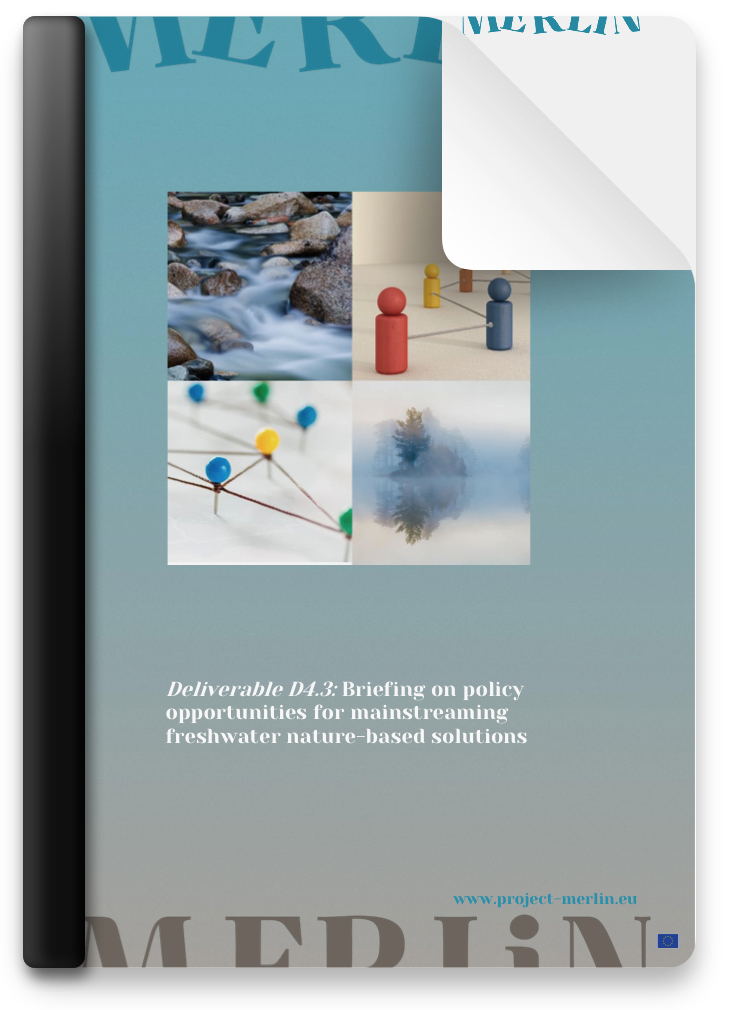
Key messages:
- Transformation (a fundamental change in scale and pace) is required to mainstream freshwater restoration across Europe.
- European Union (EU) public policies are a lever for transformation, through creating new opportunities, maintaining good practices and disrupting drivers of degradation.
- Six EU policies relevant to six economic sectors (Agriculture, Hydropower, Insurance, Navigation, Peat Extraction and Water Supply and Sanitation) were reviewed. The implementation of four policies in selected Member States was also assessed.
- The policies could do more to make the types of measures being demonstrated in the MERLIN case studies more visible.
- The policies can promote Nature-based Solutions (NbS) using the IUCN Global Standard criteria to ensure that all aspects of NbS are properly considered.
- All six economic sectors have the potential to play an important role in promoting the use of freshwater NbS; some sectors such as the Peat Extraction or Insurance sector could be more visible.
- Policies need to work together with aligned objectives, instruments and implementation to have a coherent approach to the biodiversity, climate and economic crises.
- Strategicpolicyplanningprocesses(suchasCommonAgriculturalpolicy strategic plans) can play a role in promoting freshwater NbS and developing cross-sectoral, catchment scale interventions. Review processes for these plans, and for permits or licences, can be triggers for change.
- There are several policy review opportunities arising between now and 2030 to embed freshwater NbS as a mainstream practice.
Deliverable D4.4
Value Chain Analysis in Key Economic Sectors (09/2024, updated 04/2025)

Key messages:
-
Using Value Chain Analysis to Promote NbS:
This report applies Value Chain Analysis (VCA) to key economic sectors within the MERLIN project, exploring how Nature-based Solutions (NbS) can be integrated into freshwater ecosystem restoration. The focus of VCA is to understand and illustrate the mechanisms through which value is created across sectors, including economic, social, and environmental dimensions. This extended approach goes beyond conventional analyses that prioritise commercial value, emphasising how NbS contribute to broader societal and ecological benefits.
By examining examples from the Water Supply and Sanitation (WSS), Agriculture, Insurance, and Peat Extraction sectors in Europe, the report demonstrates that VCA is an effective tool for promoting NbS adoption. It highlights how NbS create value in ways that are both attractive to businesses and aligned with sustainability goals. -
Synergising Economic and Ecological Gains with NbS within Value Chains:
Nature-based Solutions (NbS) provide an opportunity to align economic and ecological goals within value chains. By identifying sector-specific value chain challenges, integrating NbS helps make environmental resilience and economic interests mutually beneficial. Enhancing freshwater ecosystem resilience with NbS is not just corporate responsibility or green marketing but a strategy for generating commercial benefits. While initial external support may be needed to kickstart NbS, long-term gains such as reduced costs, risk mitigation, and enhanced reputation make NbS attractive for businesses, ultimately driving internal investment. -
Leveraging Financia Support to Implement NbS across Value Chains:
Pro-environmental capital investments and financial incentives are crucial in driving the adoption of NbS across value chains. These supports enable key actors to gain economic advantages while implementing sustainable practices, creating win-win scenarios that make NbS integration commercially viable in the long term.
However, the role of standards is equally important in ensuring consumer support for NbS. Certification schemes and labels, while helpful, often face challenges due to the proliferation of different standards, some of which lack proper accountability mechanisms. For example, schemes like the RPP (Responsibly Produced Peat) support freshwater NbS but remain largely invisible to consumers, limiting their impact. Streamlining standards and enhancing transparency can help ensure broader consumer awareness and support for NbS. -
Enhancing Standards for NbS Integration into Value Chains:
Many sectoral standards need to be renewed or updated for the purpose of a more comprehensive integration of NbS, with possibilities to involve a certification scheme or consumer label issuing procedure. More up-to-date sectoral standards are considered as an institutional instrument to provide systematic solutions to include NbS into value chains, as they provide a structured framework for ensuring that NbS are implemented effectively, facilitating their adoption while offering long-term economic and environmental benefits. This is particularly important for aligning value chains with broader environmental goals.
Deliverable D4.5
MERLIN has also developed six inspiring visions of how economic activities can integrate Nature-based Solutions — six unique action plans that have the potential to transform business-as-usual. Read the individual strategies here
Focus Sectoral Strategies for mainstreaming freshwater restoration (01/2025)
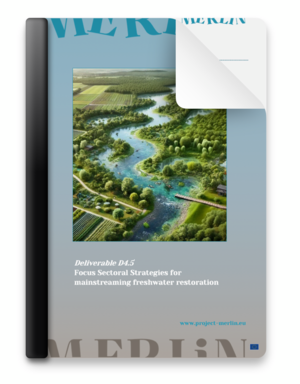
Key messages:
- The six MERLIN Sectoral Strategies provide a vision for integrating Nature-based Solutions (NbS) into key economic sectors (Agriculture; Hydropower; Insurance; Navigation; Peat Extraction; Water Supply and Sanitation).
- Economic sectors both depend on and impact freshwater ecosystems—NbS align private benefits with public goods like flood risk mitigation.
- The business case for NbS includes cost reduction, risk management, regulatory compliance, sustainability commitments, and brand value.
- The Strategies promote not only freshwater measures but also a shift toward recognizing natural capital as a business priority.
- These Strategies aim to foster Communities of Practice (CoPs), engaging businesses, policymakers, financial institutions, and sectoral associations. as well as other civic and financial institutions.
- Actions cover 'why,' 'what,' 'when,' and 'who'— starting with evidence gathering, followed by knowledge sharing, capacity building, policy shaping, and securing funding.
- Collaboration is key, requiring cross-sector partnerships at catchment, national, and EU levels, alongside policy support from non- environmental sectors.
- An enabling policy environment is essential, with non-environmental sectors (e.g., Agriculture, Energy) needing to support NbS.
- With rising economic competitiveness concerns, sectors show interest in NbS, but further work is needed to turn strategies into action.
Deliverable D4.6
Sectoral Strategy Infographics (03/2025)
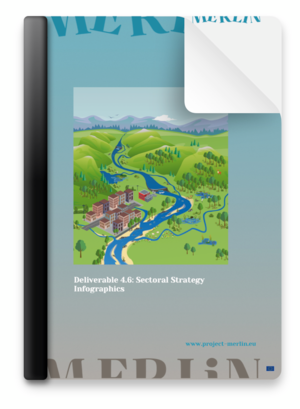
Key messages:
-
The infographics are based on the six MERLIN Sectoral Strategies which provide a roadmap for integrating Nature-based Solutions (NbS) into key economic sectors: Agriculture, Hydropower, Insurance, Navigation, Peat Extraction, and Water Supply and Sanitation.
-
Economic sectors play a crucial role in both impacting and benefiting from freshwater restoration. These strategies provide clear, actionable pathways for aligning Sectoral priorities with NbS implementation.
-
The infographics illustrate each sector’s vision, core actions, and interpretation of NbS, making complex strategies more accessible and easier to distribute.
-
By presenting key concepts visually, the infographics invite non-academic audiences - policymakers, industry experts, and the public - to better engage with sector-specific approaches to NbS.
Read more about the Sectoral Activties
Deliverable D4.9
Just transformations (08/2025)

Key messages:
-
The use of nature-based solutions (NbS) in freshwater restoration must ensure fair, active, and transparent involvement of diverse stakeholders, and balance the distribution of costs and benefits they incur.
-
A synthesis of MERLIN NbS case study data, illustrated by six examples, shows that the way stakeholder engagement is designed and executed has critical implications for achieving such ‘just transformations’. The analyses focused on representation, procedure, and distribution.
-
Representation analysis shows that a broad range of stakeholders were engaged, but public-sector stakeholders often dominated, which may result from their traditional role in natural resource conservation and environmental protection.
-
Initiatives like case study boards and workshops promoted active stakeholder involvement, but community groups were often less actively engaged, reinforcing public-sector representation.
-
NbS benefits were generally well communicated and positively perceived, but there was limited clarity regarding costs, beneficiaries, and compensation schemes for affected stakeholders.
-
It is important to address the power dynamics and politics of restoration while building trust amongst stakeholders to galvanise support. Community groups and sceptical stakeholders need to be fully engaged and given space to voice concerns and to constructively find solutions. This requires significant time and resources. It also requires willingness to compromise.
-
Engagement and decision-making approaches should respond to different stakeholders’ needs, while ensuring flexibility to involve a range of stakeholders properly.
-
Capacity building for project leaders is critical to identify and address the root causes of opposition to NbS, low interest in participation and their implications for just transformations. This can help address low participation amongst some stakeholder groups.
-
To enable early detection of gaps and timely corrective actions, stakeholder engagement should be planned from the outset with tools in place to systematically monitor and evaluate participation.
-
Context is important, and each case study offers unique lessons, stressing there is no one-size-fits-all approach when implementing NbS within a just transformations framework.
Deliverable D5.1
MERLIN dissemination and exploitation plan (02/2022)

Key messages:
- MERLIN has defined seven principles for making impact that build the framework for communication, dissemination and exploitation in the project.
- Along these principles, six relevant target groups are specified, for which different tools of communication and dissemination are determined.
- All activities are centred around the ‘MERLIN key outputs’, which are the 33 project deliverables with public dissemination level.
- These key outputs are grouped into clusters to streamline the communication and dissemination activities along six main thematic strands.
- Centrepiece of this dissemination and exploitation plan is the specification of all MERLIN key outputs and the envisaged dissemination and exploitation channels.
- Eleven key performance indicators and target values have been identified for the different communication and dissemination tools.
Deliverable D5.2
MERLIN website and leaflet (01/2022)

Key messages
- The MERLIN webpage serves to inform the scientific community as well as the general public about the MERLIN project, its aims and its activities.
- The MERLIN webpage will continuously be updated and amended with MERLIN results and related information during the project’s lifespan.
- The MERLIN leaflet is meant to inform the public about restoration and nature-based solutions in general and specifically about the MERLIN project.
- The MERLIN leaflet will be translated into all case study languages.





